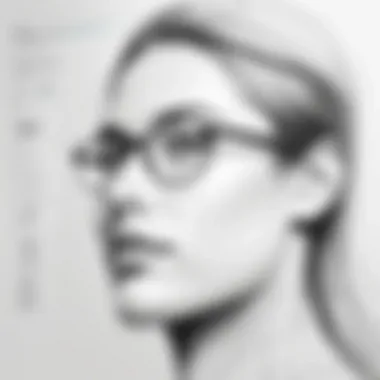Exploring Simple Sketching Software: A Comprehensive Guide


Intro
In recent years, the landscape of digital sketching has undergone a remarkable transformation. Simple sketching software has emerged as a fundamental tool for artists, designers, and enthusiasts alike. This guide aims to navigate through the essential aspects of these programs, guiding users in selecting the right application for their creative endeavors. Whether you are a beginner picking up your first stylus, or a professional seeking to streamline your workflow, understanding the available options is crucial.
Overview of the Technology
When it comes to simple sketching software, one must consider the underlying technology that powers these applications. The features offered vary across platforms, but some common specifications include ease of use and accessibility across devices.
Key specifications
- Cross-platform compatibility: Many modern software options function on various operating systems, allowing users to create on their preferred device.
- Cloud integration: This feature ensures that sketches are saved and accessible from any location, fostering workflow flexibility.
- User-friendly interfaces: Simplified menus and intuitive design promote quick learning curves.
Unique selling points
Simple sketching software sets itself apart through distinct advantages. These tools often emphasize spontaneity in creativity, allowing users to sketch quickly without extensive setup.
- Affordability: Many options are available for free or at low costs, making them accessible to a wide audience.
- Community support: Platforms often have active user bases that contribute tutorials, tips, and inspiration, enhancing the overall user experience.
"The right sketching software not only enhances productivity but also nurtures creativity, making it an invaluable resource in the digital age."
Design and Build Quality
The design and build quality of sketching software affect both usability and the overall experience. Users should pay attention to how these applications handle input, visual fidelity, and ergonomic considerations.
Material used
While the software itself does not involve physical materials in the traditional sense, the technology supporting graphics rendering and responsiveness is essential. High-quality vector processing and bitmap capabilities determine how smoothly sketches appear and how well they respond to input.
Ergonomics and usability
Usability is paramount for an enjoyable sketching experience. A well-designed application allows for:
- Seamless navigation through tools and options.
- Customizable shortcuts to boost efficiency.
- Compatibility with stylus and touch input for more natural drawing.
Exploring the realm of sketching software reveals a continuously evolving landscape where functionality meets creative expression. Identifying the right tool for your unique needs can significantly enhance your digital sketching journey.
Intro to Simple Sketching Software
Simple sketching software serves as a bridge between traditional pen-and-paper sketching and the digital realm. In today's fast-paced design landscape, the need for efficient and user-friendly tools is paramount. This article aims to explore various aspects of simple sketching software, shedding light on its features, applications, and significance.
Defining Simple Sketching Software
Simple sketching software refers to digital applications designed to facilitate the creation of sketches, drawings, and diagrams with minimal complexity. Such tools usually offer intuitive interfaces that cater to users of varying skill levels, making the process of sketching more accessible. They often include essential drawing functions such as pencil, brush, shapes, and text tools, while avoiding overwhelming users with extensive features. The essence of simple sketching software lies in its ability to empower creativity without the steep learning curve associated with professional-grade applications.
Importance in Digital Design
In an era where visual communication is paramount, simple sketching software plays a crucial role in digital design. These tools enable rapid prototyping of ideas and concepts, allowing designers to express their vision swiftly. Their importance is evident in several areas:
- Enhancing Creativity: By removing barriers, these solutions encourage users to experiment with ideas freely.
- Facilitating Collaboration: Many software options include sharing features, making it easier for teams to collaborate on design projects.
- Streamlining Workflows: Simple sketching tools often integrate with other design applications, creating a cohesive workflow that sustains productivity.
Overall, the significance of simple sketching software lies in its capacity to enhance productivity and creativity, making it a cornerstone of contemporary design practices. By understanding its functions and benefits, users can select the right tool that aligns with their creative needs.
Key Features of Simple Sketching Software
Understanding the key features of simple sketching software is essential for anyone looking to create digital art or sketches. This section emphasizes why these elements are not just optional but critical for a successful design experience. Elements such as user interface, tool variety, and collaborative capabilities significantly impact how effectively users can express their creativity.


User Interface and Experience
User interface (UI) profoundly influences how users interact with sketching software. A well-designed UI should be intuitive, allowing users to navigate the software without hindrance. Clarity is vital; the layout must enable users to find tools quickly. Icons and menus should be logically organized. It helps reduce the cognitive load on users, making the creative process smoother and more enjoyable.
Responsive design also plays a crucial role. As devices like tablets and smartphones are becoming popular, sketching software need to adapt seamlessly to different screen sizes. Touch functionality is another consideration. Some software offers gesture control, allowing easier and faster interactions.
Tool Variety and Functionality
A broad range of tools enhances the capabilities of sketching software. Basic functions like pencil, brush, and eraser are fundamental. However, software that includes advanced options such as layers, customizable brushes, and texture options adds significant value. These functions allow for more complex and professional-looking designs.
Functionality extends beyond tools. The ability to import various file types can also be a huge benefit. Some tools enable users to integrate graphics from external sources or create vector formats. Thus, choosing software with extensive tool variety contributes directly to the quality of the final artwork.
Collaboration and Sharing Options
In today’s digital environment, collaborative features are essential. Many sketching platforms now offer real-time collaboration tools. This allows multiple users to contribute simultaneously to a single project. It is particularly beneficial in professional settings where teamwork is vital. Users can get instant feedback and share insights right within the application.
Sharing options are equally important. Seamless integration with social media platforms like Facebook or professional portfolios can streamline the sharing process. Exporting options that support multiple formats ensures users can showcase their work in various ways. These collaborative and sharing elements can enhance the overall user experience and broaden the utility of the sketching software.
Popular Simple Sketching Software Options
The choice of software can greatly influence both the efficiency of the design process and the quality of the final output. As simple sketching software becomes more prevalent among creators of all levels, understanding the various options available is essential. Each tool has unique features that cater to different creative needs, enhancing workflow and fostering innovation. Selecting an appropriate software can make the difference between a smooth creative journey and a frustrating experience.
Overview of Top Software
When looking at the landscape of simple sketching software, a few standout options emerge. Each of these tools offers distinct advantages tailored towards specific types of users.
- Adobe Fresco: This software is designed mainly for illustrators and artists. With features that emulate real brush and paper effects, users can enjoy a natural drawing experience. It also supports vector and raster graphics, which makes it versatile for various creative tasks.
- Sketchbook by Autodesk: This tool is popular for its user-friendly interface and powerful sketching capabilities. It is suitable for beginners while also offering advanced features for experienced users. The extensive brush library and customizable workspace enhance the overall user experience.
- Tayasui Sketches: This app focuses on simplicity and elegance. It is ideal for users who want to sketch quickly and intuitively. The inclusion of realistic brush strokes enhances the artistic feel of the software, making it appealing to creatives seeking a straightforward sketching platform.
- Procreate: A favorite among digital artists, Procreate offers a plethora of brushes and features that cater to complex artistic techniques. Its intuitive control system allows for seamless creations, especially on the iPad.
Each of these options presents a different perspective on what makes sketching software useful and effective, allowing users to select according to their specific artistic needs and personal preferences.
Strengths and Weaknesses of Each Tool
Every sketching tool comes with its own set of strengths and weaknesses. Evaluating these aspects can help potential users make informed decisions.
Adobe Fresco
- Strengths: Combines raster and vector graphics, offers an extensive brush library, excellent for detailing.
- Weaknesses: Can be resource-intensive, may require a subscription for full features.
Sketchbook by Autodesk
- Strengths: Easy to learn, free version available, multiple tools for sketching and drawing.
- Weaknesses: Some features are limited in the free version, lacks vector support.
Tayasui Sketches
- Strengths: Simple and intuitive interface, realistic brush effects, great for quick sketches.
- Weaknesses: Limited functionalities compared to more advanced software, lacks some advanced features.
Procreate
- Strengths: Highly customizable brushes, strong community support, frequent updates.
- Weaknesses: Only available on iOS, has a steeper learning curve for beginners.
Understanding the strengths and weaknesses of each tool provides clarity. Users can then align their choice with their project requirements and personal workflows, ultimately optimizing their creative process.
Usability Considerations
Usability is a critical aspect when selecting simple sketching software. It encompasses how easily users can learn, navigate, and use the software effectively. In this section, we will discuss the significance of usability for both amateurs and professionals who intend to enhance their digital sketching experience.
Learning Curve and Accessibility


The learning curve is often the first hurdle users encounter. A steeper learning curve can deter new users, particularly those who may not have technical skills. Software like Sketchbook and Tux Paint excel in this area, offering intuitive interfaces and straightforward tools. These features help users focus on creativity rather than getting bogged down by complexity.
Accessibility is also vital for usability. Tools should cater to various skill levels and environments. For example, platforms like Procreate provide tutorial resources, making it easier for novices to get up to speed. This reduces frustration and encourages experimentation. Most tools should strive to maintain a balance between simplicity and advanced capabilities, which can empower users to grow.
Compatibility with Devices
Compatibility is another usability factor that cannot be ignored. Users desire software that operates seamlessly across various devices—be it desktop computers, tablets, or even smartphones. For instance, Adobe Fresco is optimized for both iPad and Windows environment, ensuring users can sketch effectively regardless of their device choice.
Furthermore, hardware capabilities play a role in usability. Sometimes, software uses up significant memory or processing power, which can slow down usage on older devices. Users often prefer tools like Inkscape, which efficiently runs on less powerful setups without compromising functionality.
Remember: Selecting software that suits your device ensures a smooth and enjoyable user experience.
In summary, usability considerations are paramount for anyone exploring simple sketching software. A user-friendly interface, low learning curve, and device compatibility can significantly enhance one's creative process. Users should closely evaluate these aspects to select the software that best fits their needs, enabling them to achieve their creative exertions.
Applications in Professional Settings
The realm of simple sketching software encompasses various applications across professional fields. Understanding these use cases is crucial, as they highlight the practical advantages that these tools can provide. In sectors like architecture, design, and creative arts, harnessing the capabilities of simple sketching software can dramatically enhance workflow, creativity, and collaboration.
Use in Architecture and Design
In architecture and design, simple sketching software serves as an invaluable asset. It allows architects to create initial design drafts quickly. Programs like SketchUp and AutoCAD empower professionals to visualize concepts before moving into detailed phases. The flexibility of these tools means that architects can easily modify ideas, share drafts with clients, and incorporate feedback seamlessly.
The ability to produce sketches that represent spatial relationships is vital. Architects often use these sketches to explore layout options and structural designs. Furthermore, integrating these sketches with 3D modeling tools enhances communication with stakeholders. This collaboration ultimately leads to more thoughtful designs that consider both aesthetic and functional elements. Architects adopting simple sketching software can view their projects holistically, helping to predict challenges early in the design lifecycle.
Illustration and Creative Arts
In the field of illustration and creative arts, simple sketching software has transformed artistic processes. Artists utilize tools such as Procreate and Adobe Fresco to quickly draft ideas, which accelerates their creative workflows. The use of layers, brushes, and effects fosters a rich environment for experimentation while maintaining simplicity.
These programs also offer avenues for collaboration. Artists can share their sketches digitally with peers, inviting critique or suggestions. This interconnectedness enhances creativity, allowing for cross-pollination of ideas. Moreover, many of these sketching tools support export options that easily integrate with other design software. As a result, artists can seamlessly transition from initial sketches to polished final products, whether in digital or print formats.
"Sketching is the bridge between idea and execution, especially in professional settings where clarity and speed define success."
Simple sketching software is substantially beneficial across professional domains. By facilitating creativity and encouraging collaboration, these tools are integral to modern design practices.
Advantages of Using Simple Sketching Software
Simple sketching software offers numerous benefits that cater to both beginners and advanced users. Understanding these advantages can guide one in finding a tool that aligns with personal creativity and workflow objectives. Exploring this software reveals how it has transformed digital sketching into an accessible and efficient practice. Let’s take a closer look at some specific elements that enhance the user experience.
Enhanced Creativity and Productivity
Using simple sketching software provides a canvas for the mind's eye. This software allows individuals to manifest thoughts and ideas visually with less friction. The diverse features enable artists to experiment without the hassle of traditional tools. Actions such as undoing mistakes or layering sketches are easy, promoting a more explorative approach to creativity.
Moreover, such software often includes brushes, colors, and tools that mimic physical materials. Users can switch between different techniques faster than in a physical environment. This flexibility can lead to innovative ideas that may not happen otherwise, enhancing creative output significantly.
In a professional context, productivity improves. Having tools at one’s fingertips means less time spent setting up and more time spent creating. Automated functions can handle repetitive tasks. Therefore, artists focus their energies on ideating or refining concepts rather than managing logistics.
Streamlined Workflow
A streamlined workflow is a crucial factor in the efficiency of any creative process. Simple sketching software integrates various functionalities into one platform. This integration minimizes the need to switch between different applications or tools, which can disrupt focus.
For example, features like layers, file management, and sharing capabilities facilitate smooth transitions from drafting to finalizing. Access to your sketches anywhere ensures that inspiration can be captured on the go. Users can import and export files easily, aiding collaboration in team settings or feedback loops.
Additionally, many applications offer cloud storage options. This means that project files are safer and can be accessed from multiple devices. Therefore, users have the flexibility to sketch at their convenience and ensure that their work remains organized.
"Simple sketching software transforms the sketching process, combining creativity with efficiency, enabling users to harness their full potential."


In summary, simple sketching software not only enhances creativity and productivity but also streamlines workflows. Understanding these advantages is fundamental for users looking to elevate their digital design processes.
Challenges and Limitations
Understanding the challenges and limitations of simple sketching software is essential for users. These aspects can significantly impact the overall experience and effectiveness of the software. Knowing what to expect helps in making a more informed decision when choosing a tool for sketching. Moreover, being aware of these potential drawbacks allows users to strategize around them, ensuring that their creative processes remain efficient.
Technical Restrictions
Simple sketching software often has technical restrictions that may affect performance. These can vary from software to software, influencing how effectively users can execute their creative ideas.
- System Requirements: Many applications have specific system requirements that may not be met by all devices. Users with older hardware might face challenges due to insufficient processing power or memory.
- Internet Connectivity: Some sketching software operates primarily online, requiring a stable internet connection. This can be a limitation for users in areas with poor connectivity.
- Export Formats: Not all software is compatible with various file formats. This can restrict how users share or collaborate on projects, limiting integration with other tools.
- Performance Limitations: Certain programs may lag or crash when handling more complex designs, which can disrupt workflow and affect productivity.
Staying informed about these technical limitations is vital. Users can choose solutions that align better with their capabilities and needs.
User Experience Issues
User experience is a crucial aspect when working with simple sketching tools. It can either enhance or impede creativity. Below are several common user experience issues:
- Intuitive Design: Some software may not have an intuitive layout, making it challenging for new users to navigate the interface effectively. This can lead to frustration and wasted time.
- Tool Accessibility: If essential tools and features are buried in menus or hard to locate, it can slow down the creative process significantly.
- Tutorials and Support: A lack of helpful tutorials or customer support can leave users in the dark, especially those who are not technically inclined. Comprehensive support resources are necessary for troubleshooting and learning.
- Frequency of Updates: If a software is not regularly updated, it may lack features essential for modern sketching needs. Users may feel they are missing out on valuable tools that can enhance their creativity.
Awareness of these user experience issues can guide users toward finding the right sketching software that not only meets their technical needs but also supports a positive and productive creative environment.
Future Trends in Sketching Software
The landscape of sketching software is undergoing significant transformations influenced by emerging technologies and evolving user needs. These trends not only affect the features and functionalities of the tools available but also redefine how users interact and create within these environments. As digital design continues to expand, understanding the future directions of sketching software is imperative for both current users and those looking to enter the field. The integration of advanced technologies and personalized features will play a pivotal role in enhancing productivity and creativity among designers and artists.
Integration with Emerging Technologies
Emerging technologies are reshaping the capabilities of sketching software. One notable advancement is the application of artificial intelligence. AI tools can now assist in automating repetitive tasks, providing suggestions for designs, and even generating initial sketches based on user inputs. This capability allows users to focus their creative energies on refining concepts rather than getting bogged down in the initial stages of sketching, making the process more efficient.
Another important trend is the increasing incorporation of augmented reality (AR) and virtual reality (VR) elements in sketching applications. AR tools enable creators to overlay their sketches onto physical environments, facilitating a more immersive and interactive design experience. In contrast, VR platforms provide entirely virtual environments where users can sketch in three dimensions. Such technologies not only enhance the way ideas are visualized but also open new avenues for collaboration, allowing users to work together in an immersive space, regardless of their physical locations.
Lastly, the trend towards cloud-based solutions cannot be overlooked. These platforms offer seamless access to sketches across devices, promoting easy sharing and collaboration. This flexibility nurtures a more connected design community, where feedback and iteration can happen in real-time. By leveraging cloud technology, sketching software is moving towards a more dynamic user experience.
Adaptation to User Needs
As sketching software evolves, a critical focus is on adapting tools to better suit the diverse needs of users. User-centered design principles are shaping software developments, ensuring that features cater to a spectrum of skill levels, from novices to experienced designers. This responsiveness enhances the user experience significantly. Simplified workflows are being implemented to make powerful tools accessible without overwhelming the user.
Additionally, customization options are expanding. Users now can personalize their interfaces, tool palettes, and settings to align with their individual project requirements and preferences. Adaptive interfaces that transform based on user habits are becoming more common. This means that the software can prioritize tools that users engage with regularly, reducing the learning curve and fostering productivity.
Furthermore, accessibility is a growing concern. New sketches programs are prioritizing inclusive design, ensuring that their tools are usable by people with varying abilities. This includes options for voice commands, alternative input sources, and configurations for different visual needs.
In summary, the blend of emerging technologies and adaptability to user needs forms the foundation of future trends in sketching software. As these tools continue to evolve, they will significantly enhance the creative process, empowering users to express their ideas with greater ease and efficiency.
Epilogue
The conclusion of this article serves as a crucial wrap-up to the various elements discussed regarding simple sketching software. Throughout the sections, we have explored the defining characteristics, usability, and diverse applications of these tools. Understanding the importance of selecting the right sketching software can significantly impact the creative process.
Summary of Insights
To summarize the insights gained, simple sketching software is more than just a set of tools. It provides an accessible platform for users of all skill levels to express creativity and enhance productivity. The importance lies in the variety of features these programs offer, from user-friendly interfaces to collaboration options. Additionally, the software's adaptability to various professional settings emphasizes its relevance in today's digital age. Key points that emerged include:
- User Interface and Experience: A good interface aids smooth navigation.
- Tool Variety: Having multiple tools allows for more creative freedom.
- Usability: Accessibility empowers more people to engage in sketching.
These insights reflect newer trends and the growing importance of these tools in digital design.
Final Thoughts on Choosing the Right Tool
When it comes to choosing the right sketching software, considerations are essential. Users should evaluate their own needs against the features offered by different tools. Here are some factors that can guide decision-making:
- Skill Level: Beginners may prefer software with easier learning curves.
- Specific Uses: Identify whether the focus is on illustration, architecture, or other applications.
- Budget: Consider the cost of software against its value to your work.
In this fast-evolving tech landscape, users must remain aware of the showing advancements. Keeping pace with new offerings will ensure that one selects the most appropriate tool for their creative endeavors. Whether you are a casual doodler or a professional designer, the right software can greatly enhance both your workflow and output.







